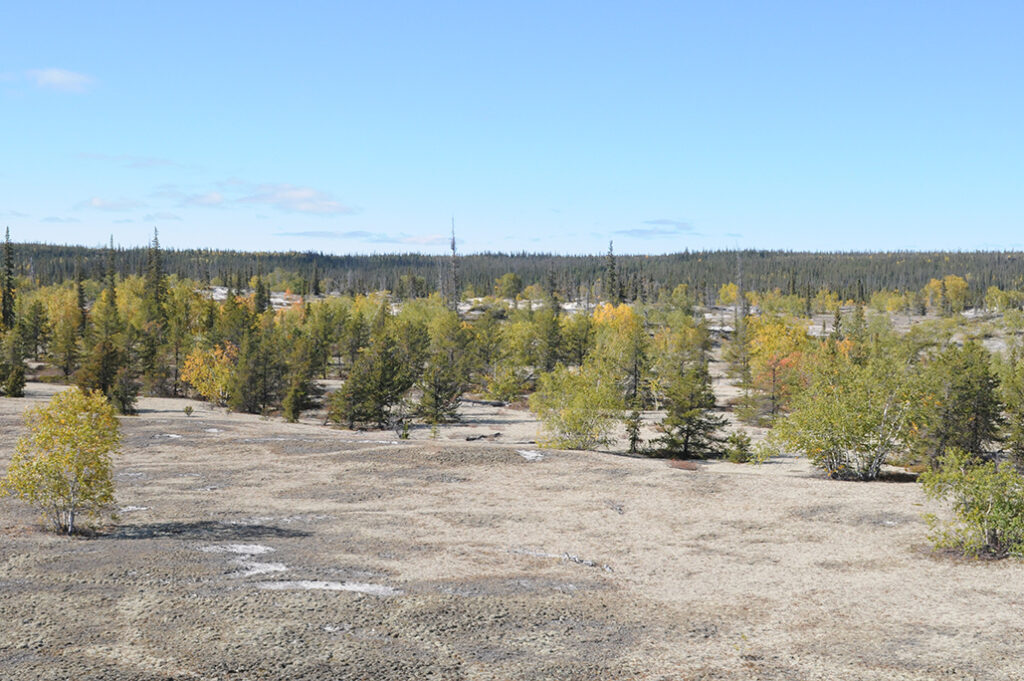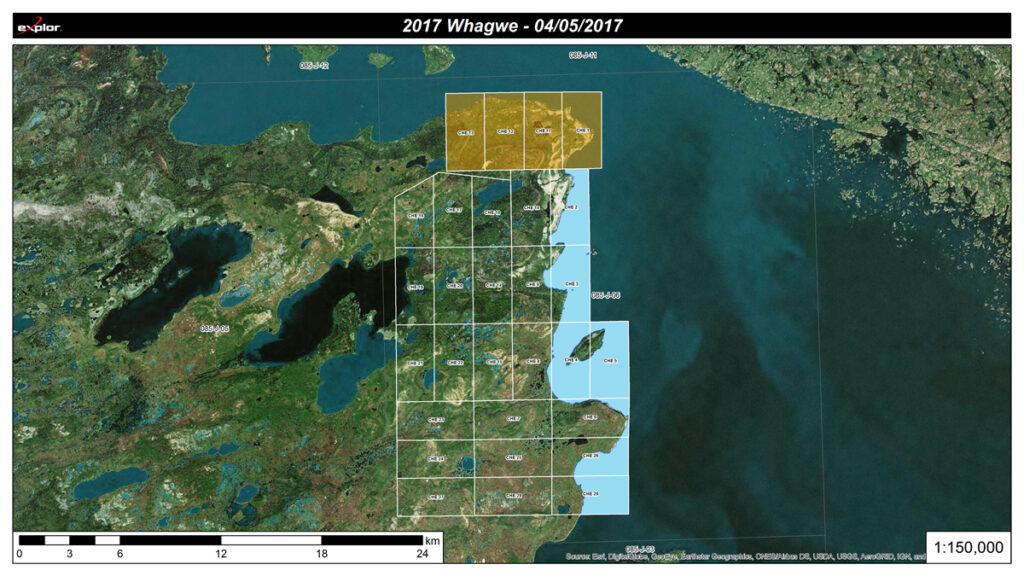A Tech Boon in Every Grain
Could a High Quality Silica Sand Deposit at Yellowknife’s Doorstep Have Commercial Potential?

It’s all in the sand, or more accurately, the silica sand.
Also called quartz sand, silica sand is mostly silicon dioxide (SiO2), and is the essential ingredient for many of the technological necessities of modern life. It’s plentiful and easy to mine so offers ready supplies of silica for the glassmaking industry, silicon for hundreds of other uses such as fibre optic lines, and, if certain properties are present, it can also be used as fracking sand by the oil and gas industry.
The Northwest Territories has millions of tonnes of it, but none is quite so pure as the deposit at the Chedabucto project, just 50 km west of Yellowknife across the North Arm of Great Slave Lake at Whitebeach Point.
It has captured the interest of Allan Châtenay, president of Explor, a seismic data acquisition and licensing company with decades of Northern experience. “When you look at the property on Google Earth it just jumps out at you and you realize this is a pretty special resource,” he says. “It is extended. It covers a wide expanse of terrain and what we’d like to do is delineate it.
With all of the work that’s come before, it hasn’t yet been delineated. In fact nobody has even determined how deep the sand is.”
Châtenay has a professional hunch that the sands at Chedabucto just might be the foundation of a new industry for the NWT, and that it might be a new direction for his so far pure exploration company.
But right now that’s only a “maybe.”
There’s a lot to be proven before it could become reality.
Explor acquired the rights to explore the deposit when Husky Energy decided not to pursue its own exploration program, called the Chedabucto Silica Prospect, which was originally planned for 2015. Husky withdrew its land use application filed with the Wek’eezhii Land and Water Board, following the board’s June 2015 decision to refer the project to the Mackenzie Valley Environmental Impact Review Board for an environmental assessment. The Wek’eezhii board cited public concern voiced by the Tłįchø government, the Yellowknives Dene, and the North Slave Métis Alliance as the reason for the referral.
“So we approached Husky and began a process of negotiation that culminated in a mining option agreement,” says Châtenay. “That agreement gives us the exclusive ability to explore on the 29 claims.” Husky Energy continues to hold the all the claims, but Explor has elected not to explore on the four Northern-most claims, following discussions with the Tłįchø. Explor has renamed the project Whagwe, which means “sandy ground covered in pine trees with very little undergrowth” in the Tłįchø language.
Explor’s pursuit isn’t entirely a shot in the dark. The deposit has been studied before by the Northwest Territories Geological Survey (NTGS), that completed a NWT-wide survey of silica sand deposits in 2014. Scott Cairns, Manager, Mineral Deposits and Bedrock Mapping at NTGS, participated in that survey and notes the exceptional quality of the Chedabucto deposit.
“While silica is very common, end uses have very demanding parameters and that can make occurrences of the correct type of sand very difficult to find,” he says. “The ones we have seen that are quite pure silica sands are unusual in the NWT.”
The NTGS survey took samples from representative areas such as the dune sands inland and the disaggregated, wave-washed sands near the shore. All appeared highly promising. “Our samples have shown it to be very pure, very well-sorted and rounded quartz grains and that’s very favourable for a high-value silica deposit,” says Cairns.
How Low Does It Go
The areal extent is clear from satellite maps and air photos, but Cairns says the depth of the deposit has not yet been determined. “The company Husky had working there [Aurora Geosciences] did some drilling and geophysics but the wild card is permafrost,” says Cairns. “With the equipment and techniques they were using, it is difficult to tell if it was depth to permafrost or to underlying bedrock.”
Determining that depth tops Châtenay’s plans for this summer, employing “some very advanced dynamic and intelligent drilling techniques,” he says. Drill-hole locations won’t be defined upfront. Instead, locations will be chosen as the summer project proceeds, based upon results of previous holes. “We’ll learn at each step of the way,” says Châtenay. “So that’s what we envision, that we have a very dynamic program where we deploy professional geoscientists coupled with advanced heli-portable drilling methods and we drill intelligently.”
He says geophysical components will complement the drilling, including ground penetrating radar and resistivity testing.
“These kinds of data can tell us a lot about the depth of things,” he says. “With each physical data point we get, we can calibrate these geophysical properties and maybe we can get good enough so that we only need to do the geophysics going forward, so we can do much less drilling.”
Explor will modify the program as it advances to deal with potential problems like water tables.
“And I think we will probably encounter permafrost, so we may end up dealing with frozen sand which might be challenging to drill through,” Châtenay says. “These are things we really don’t know until we get out there and do the work.”
For testing of bulk samples they’ll be following protocols including National Instrument 43-101, or NI 43-101. “That is designed to make sure that mining and exploration companies follow a rigorous, transparent process,” he explains. “And that means independent, accredited laboratories and at least two samples from each location.”
Building Relationships
Châtenay hopes to get the program underway this summer, but he says a big part of going forward is understanding the positions of the different Indigenous groups in the area: the Tłįchø, the Yellowknives Dene, and the Métis.
For example, in a May 2017 news release, the Tłįchø stated, “The Tłįchø Government does not support development or exploration of the area; its priority values lie in the cultural and ecological realm.”
They also objected to using the name Whagwe.
“The Great Slave Lake region is a complex political landscape and for whatever reason there is quite a bit of emotion around the project, and I think most of it is completely unnecessary,” Châtenay says. “Which is tragic, because when you look at the economic status of some of these outlying communities, it’s not acceptable.”
The GNWT’s Department of Industry, Tourism and Investment didn’t respond to interview requests regarding potential government economic involvement, but clearly, promotion of value added production is on the radar. For example, in the GNWT’s Economic Development plan, Recommended Action #58 states: “Encourage value added processing of materials sourced in the NWT” for an expected outcome of: “…value added production, sales and distribution (in any form) can mean increased employment and economic activity in the NWT.”
Should the quality and quantity of the Chedabucto silica sands be good enough to compel commercial development, extensive market research and feasibility studies would be needed first and foremost. Potential uses might include frack sand, glassmaking, or silicon manufacturing. Each has its own level of sophistication and set of standards.

Strong Demand for Sand
Silica mining uses simple open pit or dredging methods with generally standard mining equipment. Good frack sand needs little extra processing, and the market for it is forecast to remain strong as producers increase not only the number of wells drilled but also the tonnage of sand used per well.
According to a forecast by the Freedonia Group, through 2020 silica sand used in hydraulic fracturing “will represent the fastest expanding market for industrial sand. North America will continue to dominate the hydraulic fracturing market for silica sand, accounting for over 90 per cent of the 2020 segment total.”
Much of the frack sand for Northern B.C. and Alberta shale plays is imported from the U.S., but two Northern Alberta producers, LaPrairie Group and Athabasca Minerals, offer silica sand for sale.
The outlook for Canada’s glass manufacturers – Industry Canada lists 24 of them – doesn’t look nearly as promising.
According to a March 2017 report by the market research firm IBISWorld, over the five years to 2017, the glass product manufacturing industry in Canada declined as consumers and businesses increasingly turned away from the use of domestic glass toward substitutes such as plastics and metals, and less expensive glass imports.
“Falling industry profitability and the rising prominence of imported goods have encouraged many companies to exit the industry entirely,” states the report. IBISWorld expects revenue to continue declining to 2022 as glassmaking in Canada is in the “declining stage of its economic life cycle”.
Silicon manufacturing is more sophisticated. Silicon is made by reacting silica with carbon materials like coke, coal or wood chips. The reduction process heats silica and carbon in an electric arc furnace, driving off the oxygen, leaving silicon.
The resulting silicon metal, often in powder form, is packaged for shipment to manufacturing centres depending upon how it is to be used. Silicon has hundreds of industrial applications such as for computers, memory chips, solar panels, electronics, automobiles, textiles, healthcare products, construction, architecture, and household products. Ferrosilicon alloys are used to improve the strength and quality of iron and steel. Silicon, when mixed with aluminum, makes it easier to be welded or molded. It’s the starter for silianes, employed to make resins, lubricants, anti-foaming agents, and water-repellent compounds used on raincoats, tents and other applications.
Clearly, in order to consider any added value to NWT silica sand, several independent, comprehensive market studies would be needed.
And there’d be competition. According to the U.S. Geological Survey figures, of the 7.2 million-tonne world silicon production in 2016, China produced 4.6 million tonnes, followed by Russia with 747,000 tonnes and the U.S. with 396,000 tonnes. Canada placed 13th, with 54,000 tonnes.
Overall, Châtenay isn’t deterred.
“We would hope to participate in the ultimate development of the resource. It’s pretty exciting. To me it would really put the NWT, and by extension the Tłįchø, the Yellowknives Dene and the Métis at the crossroads of the modern world.” ABQ

